- Related articles
- How is data transmitted in fiber optic cables?
- All Cisco XENPAK-10GB-ER+'s information (List price, Specs, Compatibility matrix)
- Optical Transceivers for Cisco WS-C3650-24TS-L Switch
- All Cisco DS-CWDM-1470's information (List price, Specs, Datasheet PDF, Compatibility matr
- Basic Information of Intel Ethernet Card
- All Cisco DWDM-XENPAK-31.90's information (List price, Specs, Datasheet PDF, Compatibility
- All Cisco QSFP-40G-PLRL4's information (Specs,Compatibility matrix)
- Optical Transceivers for Cisco SF250-48-K9-EU Switch
- Optical Transceivers for Cisco N5K-C5010P-B-S Switch
- Optical Transceivers for Cisco SG500-28-K9-G5 Switch

There have been numerous different form factors and optics types introduced since 10 gigabit Ethernet has been launched years ago. XENPAKS, the oldest, is very popular as the install base is large, while the newest SFP+ offers a much smaller form factor and the ability to offer 1G/10G combo ports on hardware for the first time. Now there are four standard modules/form-factors available.
Main module types and optical standards
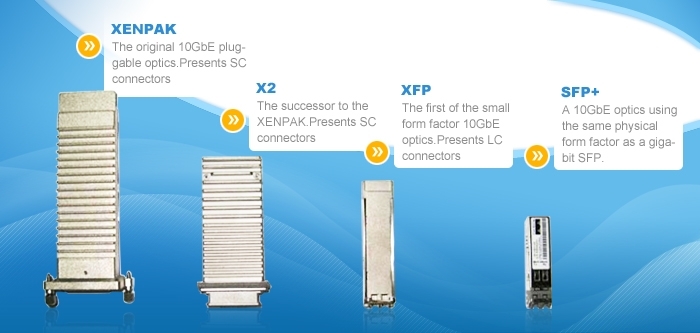
XENPAK
- Used primarily by Cisco and Juniper. The 4-port Cisco module WS-X6704-10GE is still very popular
- Very large module that includes some PHY logic in the package (example – WAN PHY capability on a XENPAK card is placed on the optic, while this capability on an XFP or SFP+ based interface is placed on the linecard)
- Uses SC connector for fiber or CX4 (Infiniband) for copper

X2
- Reduced-size evolution of the XENPAK
- Used almost exclusively by Cisco and HP
- Same general capabilities as XENPAK
- 30% reduced footprint allowed 10G port densities to increase by 2X and then 4X in Cisco modules
- Introduced a converter module to convert X2 modules to 2X1G or 1XSFP+ (please note the TwinGig converters have many compatibility restrictions)
- Uses SC connector for fiber or CX4 (Infiniband) for copper
- X2 form factor is the ONLY option for pluggable 10GbE-T

XFP
- Small form factor optic, no PHY logic
- Moving the PHY logic to the linecard gave made it possible to make 10G/OC192 dual-rate optics
- Uses LC fiber connector
- XFP is currently the smallest form factor tunable DWDM optic that is available
- Used mostly in WAN applications, due to dual-rate 10G/OC192 and Tunable DWDM offerings

SFP+
- Same form factor as SFP
- SFP+ ports are often 1G/10G, offering huge flexibility in deploying mixed environments
- (Note: some chassis have restrictions on which ports are 10G-only and which are 1G/10G)
- All major vendors are moving towards SFP+ for common 10GbE applications, especially in the Data Center
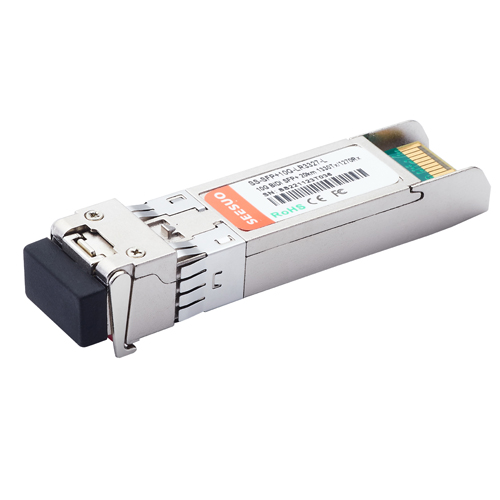
10GBase-CX4


10GBase-CX1/10GBase-CU

10GBase-T
10GBase-SR
| Core Size (microns) | Modal Bandwidth (MHz*km) | Max Distance | Notes |
| 62.5 | 160 | 26m | This is standard multimode fiber. |
| 62.5 | 200 | 33m | |
| 50 | 400 | 66m | |
| 50 | 500 | 82m | |
| 50 | 2000 | 300m | Also known as OM3 or 10GbE-optimized fiber |
10GBase-LX4
To overcome the distance limitations of SR optics, the 10GBase-LX4 standard was developed. LX4 uses 4 lasers, each operating at a different wavelength, at a 2.5Gbps data rate. This results in a range of 240-300 meters, depending on cable grade. However, due to the complex laser assembly, it is not possible to get LX4 optics in XFP or SFP+ versions. With the ready availability of OM3 fiber and newer standards that provide long reach over multimode with a single laser, LX4 is rapidly becoming obsolete.
10GBase-LRM
The replacement to LX4, 10GBase-LRM will reach up to 220m over standard multimode fiber, but without the complexity of the LX4 optics. Instead, a single laser operating at 1310nm is used. This allows LRM optics to be packaged in XFP and SFP+ form factors.
Single mode Fiber
10GBase-LR
10GBase-LR can reach up to 10km over singlemode fiber. There is no minimum distance for LR, either, so it is suitable for short connections over single mode fiber as well.
10GBase-ER
10GBase-ER can reach up to 40km over singlemode fiber. Due to the laser power, attenuation is required for links less than 20km long.
10GBase-ZR
ZR optics can reach up to 80km over singlemode fiber. Due to the very high transmit power, significant attenuation is needed for shorter links. Use of ZR optics should be preceded with an optical power test of the fiber span in question to ensure a problem-free deployment. Interestingly, 10GBase-ZR is actually not an IEEE standard, though most vendors offer a ZR option.
10GBase-LW
10GBase-LW optics use the same laser, and have the same specifications as the 10GBase-LR optics. However, the LW optics present SONET/SDH physical signaling, allowing LW-equipped devices to interface directly with an existing OC192 transport infrastructure. LW optics are only available in XENPAK and X2 form factors. XFP-based cards move this functionality from the transicever to the card itself, so make sure that if this functionality is needed, that the card itself has this support. The primary example is the as in the SPA-1X10GE-L-V2 vs. the SPA-1X10GE-LW-V2.
10G over DWDM
With 10GbE, it is possible to get optics modules that output at DWDM wavelengths, allowing for much simpler DWDM deployments, and with this optics no additional transponder hardware is required. A select few 10GbE cards even offer fixed, tunable DWDM interfaces for maximum flexibility. As one of the most confusing aspects of choosing and deploying 10Gig fiber switches, I hope this information helps. And a nod to our excellent presales engineers (thanks chris!) for putting this together for me for this article.
Quick Review of Optics Form Factors
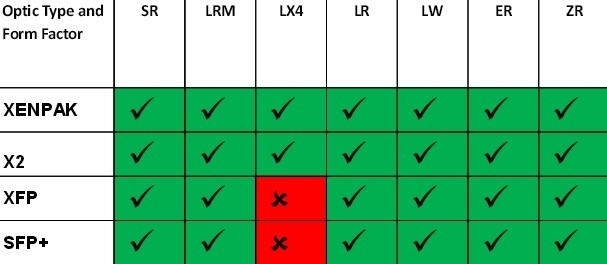
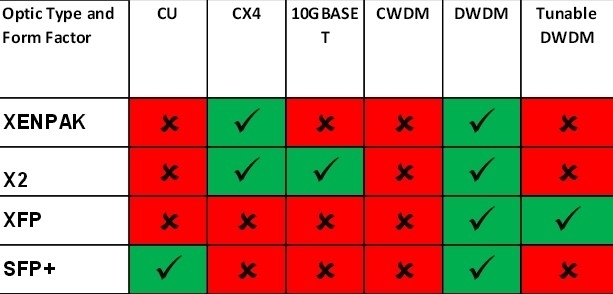
Optics Specs


Cisco DWDM SFP+ Module Overview
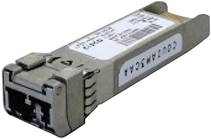
Features and Benefits
- Supports 10-Gigabit data rates from 9.9G to 11.1G (LAN, WAN, and OTU2/OTU2e) to accommodate different applications
- Smallest SFP+ module footprint in the industry
- Hot-swappable input/output device plugs into an Ethernet SFP+ port of a Cisco switch or router to link the port with the network
- Support for a “pay-as-you-grow” model for investment protection
- Digital optical monitoring capability for enhanced diagnostics and troubleshooting
- DWDM fixed module supports 40 non-tunable ITU 100-GHz wavelengths
- DWDM tunable module supports 96 tunable ITU 50-GHz wavelengths
- Supports the Cisco quality identification (ID) feature, which enables a Cisco switch or router to identify whether or not the module is an SFP+ module certified and tested by Cisco
Platform Support
- Equipment: standard SFP+ interface
- Network: dual LC/PC connector





















































